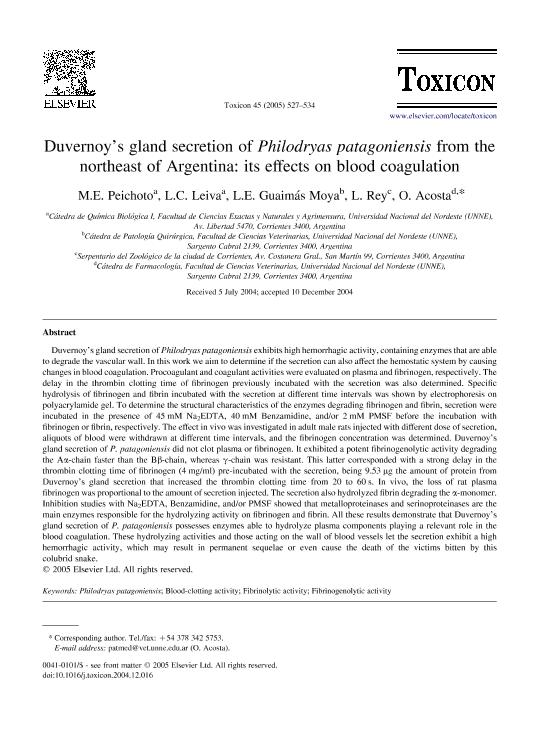Artículo
Duvernoy's gland secretion of Philodryas patagoniensis from the northeast of Argentina: Its effects on blood coagulation
Peichoto, María Elisa ; Leiva, Laura Cristina Ana; Guaimás Moya, L. E.; Rey, L.; Acosta, Ofelia Cristina
; Leiva, Laura Cristina Ana; Guaimás Moya, L. E.; Rey, L.; Acosta, Ofelia Cristina
 ; Leiva, Laura Cristina Ana; Guaimás Moya, L. E.; Rey, L.; Acosta, Ofelia Cristina
; Leiva, Laura Cristina Ana; Guaimás Moya, L. E.; Rey, L.; Acosta, Ofelia Cristina
Fecha de publicación:
03/2005
Editorial:
Pergamon-Elsevier Science Ltd
Revista:
Toxicon
ISSN:
0041-0101
Idioma:
Inglés
Tipo de recurso:
Artículo publicado
Clasificación temática:
Resumen
Duvernoy's gland secretion of Philodryas patagoniensis exhibits high hemorrhagic activity, containing enzymes that are able to degrade the vascular wall. In this work we aim to determine if the secretion can also affect the hemostatic system by causing changes in blood coagulation. Procoagulant and coagulant activities were evaluated on plasma and fibrinogen, respectively. The delay in the thrombin clotting time of fibrinogen previously incubated with the secretion was also determined. Specific hydrolysis of fibrinogen and fibrin incubated with the secretion at different time intervals was shown by electrophoresis on polyacrylamide gel. To determine the structural characteristics of the enzymes degrading fibrinogen and fibrin, secretion were incubated in the presence of 45 mM Na2EDTA, 40 mM Benzamidine, and/or 2 mM PMSF before the incubation with fibrinogen or fibrin, respectively. The effect in vivo was investigated in adult male rats injected with different dose of secretion, aliquots of blood were withdrawn at different time intervals, and the fibrinogen concentration was determined. Duvernoy's gland secretion of P. patagoniensis did not clot plasma or fibrinogen. It exhibited a potent fibrinogenolytic activity degrading the Aα-chain faster than the Bβ-chain, whereas γ-chain was resistant. This latter corresponded with a strong delay in the thrombin clotting time of fibrinogen (4 mg/ml) pre-incubated with the secretion, being 9.53 μg the amount of protein from Duvernoy's gland secretion that increased the thrombin clotting time from 20 to 60 s. In vivo, the loss of rat plasma fibrinogen was proportional to the amount of secretion injected. The secretion also hydrolyzed fibrin degrading the α-monomer. Inhibition studies with Na2EDTA, Benzamidine, and/or PMSF showed that metalloproteinases and serinoproteinases are the main enzymes responsible for the hydrolyzing activity on fibrinogen and fibrin. All these results demonstrate that Duvernoy's gland secretion of P. patagoniensis possesses enzymes able to hydrolyze plasma components playing a relevant role in the blood coagulation. These hydrolyzing activities and those acting on the wall of blood vessels let the secretion exhibit a high hemorrhagic activity, which may result in permanent sequelae or even cause the death of the victims bitten by this colubrid snake.
Archivos asociados
Licencia
Identificadores
Colecciones
Articulos(CCT - NORDESTE)
Articulos de CTRO.CIENTIFICO TECNOL.CONICET - NORDESTE
Articulos de CTRO.CIENTIFICO TECNOL.CONICET - NORDESTE
Citación
Peichoto, María Elisa; Leiva, Laura Cristina Ana; Guaimás Moya, L. E.; Rey, L.; Acosta, Ofelia Cristina; Duvernoy's gland secretion of Philodryas patagoniensis from the northeast of Argentina: Its effects on blood coagulation; Pergamon-Elsevier Science Ltd; Toxicon; 45; 4; 3-2005; 527-534
Compartir
Altmétricas



